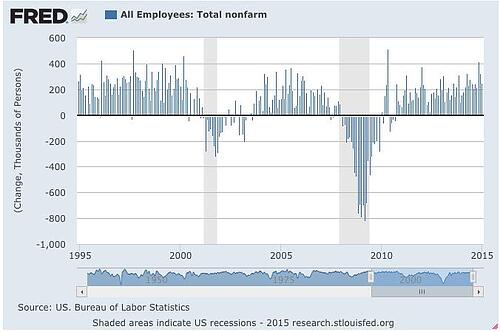 When I give talks or interviews, I’m often perceived as bullish on the U.S. recovery. In my own view, though, I’m neither bullish nor bearish, but simply driven by the data.
When I give talks or interviews, I’m often perceived as bullish on the U.S. recovery. In my own view, though, I’m neither bullish nor bearish, but simply driven by the data.
Others see it differently, especially when it comes to the employment story. Just this past week, the chairman of Gallup wrote a column titled “The Big Lie: 5.6% Unemployment.” After seeing that piece, several readers reached out to question what they see as my optimism, asking, in effect, Really? Can things really be that good?
The message from the employment report released this morning is yes, really. Again, from my point of view, this is simply a data-based conclusion, so let’s look at the numbers:
- 257,000 jobs were created in December.
- Another 147,000 jobs were added to the previous two months.
- Average hourly earnings were up 0.5 percent for the month and 2.2 percent for the year.
- Average weekly hours remained at 34.6, within 0.1 hours of the all-time high.
- Labor force participation ticked up to 62.9 percent.
These numbers aren’t just good, they’re very good, lengthening the string of strong employment reports.
Job creation on a roll
Looking at the chart below, which goes back 20 years, we see that actual job creation is better than it was in the mid-2000s, and it's close to the levels of the mid-1990s. Not only that, it has been more consistent, with the current run of 200,000-job months the longest since the 1990s.

The economy has created more than 1,000,000 jobs in the past three months alone, the most since 1997. Job growth has been strong, consistent, and sustained.
Wage growth looking up
Average hourly earnings have been slowly accelerating, and the most recent data shows a substantial uptick. Other (and possibly better) indicators of wages have shown faster growth, which means this uptick is simply bringing the AHE figure into line with the rest of the indicators. It’s becoming increasingly probable that wage growth has been faster than suggested by the headline indicator.
Wage growth has been the major weak spot, and it appears to be healing.
Even as wages have grown more slowly than would be desirable, actual wage income has risen much faster. When you combine the rapidly growing number of jobs with high hours-per-week figures and wage growth, wage income has actually been growing around 4 percent or more per year. With wage growth picking up, it has the potential to grow even faster.
Unemployment rate better than it looks
The piece of the employment report that might look worse than expected is the increase in the unemployment rate, from 5.6 percent to 5.7 percent. But there are two reasons why this isn’t necessarily a bad thing:
- First, the underlying data has changed, as it does every January when the Bureau of Labor Statistics adjusts its population estimate. This small change is probably simply a statistical adjustment.
- Second, even if it’s not a statistical adjustment, the slight increase would reflect more people moving back into the labor force, which would be a good thing overall and consistent with the rising participation rate.
The employment data doesn’t lie
There are things to worry about with the economy—the wage growth question, for example, still remains open despite today’s positive data point. But to take a downbeat view of the labor market is, in my opinion, to ignore the real data.
Today’s report is one more in a string of strong results that continue to prove the recovery is on track.


 Print
Print



